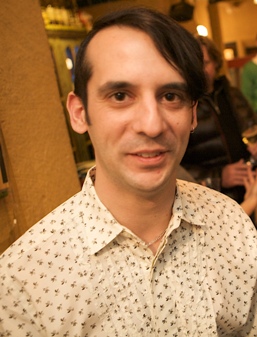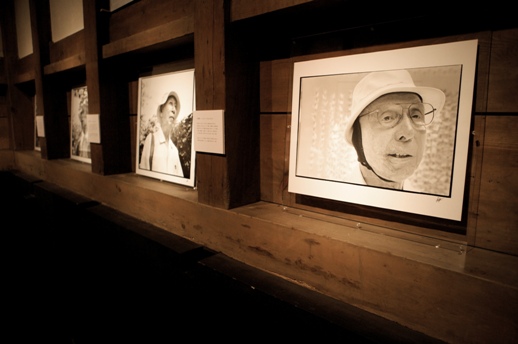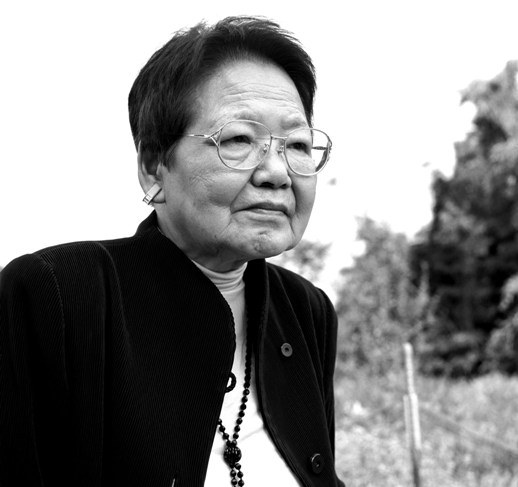Photographs Passing on Stories
Paule Saviano may well be based in New York but this is certainly not his first foray into the Tokyo gallery scene, and will likely not be his last. He started photographing music bands and fashion models, and held his colourful show “Striptease Burlesque” at Gallery ef in 2007, which has subsequently toured to China and Finland. Now he has returned to Tokyo again with a very different exhibition, “From Above”. Coinciding with the anniversary of the capital’s wartime fire bombing, his portraits show a group of resilient people, survivors from the attacks on Nagasaki and Tokyo, as they are today.

The first time I came to Japan I found out that you could actually go to the [Peace] Museums and meet the survivors…In the history books there isn’t a human face…I’m interested in human feelings and emotions, and that always lacked in the history books. I wrote a letter to the Museum at Nagasaki and they were very welcoming…I was interested in learning about [the survivors]. I kind of feel that Nagasaki is overlooked. And same for Tokyo, no one really knows what happened in Tokyo. It was a whole night of sheer hell.
And what a perfect venue Gallery ef is for this show, with its themes of memory and survival. How did you come to this gallery?
I exhibited at ef in June 2007 and that kind of planted the seeds for the Tokyo fire bombings part. Seeing an old photograph displayed at the gallery, the landscape of Asakusa one week after the bombing, I was shocked. The history book gave me the facts, the picture gave me the image of the landscape, but I still didn’t have the people. [The photographs] belong here, especially the Tokyo portion. I photographed the gallery as well.
How did you approach each portrait?
The main spirit of my work is people and emotions and feelings. That’s what I go after. There are seventeen different people I photographed and there are seventeen different ways they coped with their experiences. If you look at these pictures, you don’t see burns, you don’t see scars. You don’t see sensationalism. I don’t pose people. I just put them there, I just say, “Trust me, I won’t let you look foolish.” Ms. Mieko Toyomura has an artificial arm and a cane. But to me she is the strongest. I don’t think she moved the whole photo shoot. I moved around them.
What was the photographing process like?
In Nagasaki we went to the Peace Park. In Tokyo we actually went to the majority of [the survivors’] houses. Maybe it has a more personal feeling. It didn’t turn out to be questions and answers, it was a conversation, which drove my translator nuts! Every story was different. Every conversation was different. I work very personally. I usually just like to be with the person. I had the translator so it changed things, now it was a three-way conversation. It was a team effort. They spoke to me for about two hours. After two hours they felt comfortable with me and I felt comfortable with them. Then I started taking photos.

What aesthetic were you hoping to achieve?
I use a Hasselblad, 80mm lens. Each person was shot on twenty-four frames of film. Everything is printed black and white, the old-fashioned way. I don’t do anything to the photos, nothing digital. If you shoot full body your eye tends to wander. That’s why most of the prints are tight [on the survivors’ faces]. They looked out naturally. Distinguished, almost statuesque. That’s what you get from a low angle shooting up. Everything is in black and white because I wanted the focus to be on the people. I didn’t want the background to be distracting. It’s very subtle, very stark. I printed it straight black and white, it is so real. It is very hard to be powerful and simple at the same time, but these are.
Were you nervous as an American?
I see it as kind of the human spirit. The issue never came up of being American. They were surprised by my age. I’m thirty-four. [One lady told me] “Well, my grandson is thirty-four.”
Why do two people out of the group have two photos?
I thought they were my strongest subjects.
The frames and the prints look beautiful. What were your aims when it came to curating the works in the space?
The framing is also a part of the story. As far as I am concerned, it is not really my picture, it’s their picture. We didn’t approach it like a Peace Museum. We were able to find the balance between the art and the history. Ultimately I wanted it to be about the person. Over twelve hours we would move a picture, then go outside for thirty minutes, then come back in. The first two photos you see when you enter the gallery [are] very warm and inviting…The number one thing people are worried about with this exhibition is that they will see sensationalism. We needed to set that [warm] tone right from the first moment.

What kinds of people have been coming to the exhibition so far?
We’ve been getting a lot of older people. But there was an eighteen year old girl and she told me, “My grandmother is a survivor of the fire bombings. She’s never told me about it. I think I’m going to ask her about it.” For me, that was more important than anything else. If now she goes home and gets a story out of it…The stories are passed on. For me, that feeling is better than, [people telling me] you know, “Great picture.”
Will there be an afterlife for the exhibition?
Once this comes down, we’ll see. It was really a personal project. If we get offers, I’d love to [show it again].
Will you be coming back to Japan to do any other projects?
Gallery ef is home for my vision, my work. The first time I came to Tokyo I absolutely hated it…I thought, this is terrible, I don’t feel any personal connection. Then I came here, it felt like home. I’ve shown here twice in three years. Gallery ef for me is like the first woman you’ve ever loved.
Thanks so much for speaking to us, Paule.
For more, visit Paule Saviano’s website.
William Andrews
William Andrews



